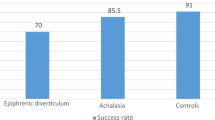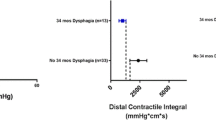Abstract
Introduction
There has been an increase in the number of patients seeking treatment after an anti-reflux surgical procedure. The objective of this study is to describe high-resolution manometry (HRM) topography as it relates to the post-fundoplication anatomy.
Methods
Retrospective review of a prospectively maintained database was conducted to identify patients who underwent esophagogastroduodenoscopy and HRM at Creighton University Medical Center (CUMC) between November 2008 and October 2010, for symptoms after a previous fundoplication. Patients were categorized as having intact, intrathoracic, disruptured, twisted, or slipped fundoplication based on endoscopic findings.
Results
Sixty-one patients {intact, 17(28%), disrupted, 2(3%), twisted, 3(5%), intra-thoracic, 18(30%), slipped, 21(34%)} are included in this study. A double high-pressure zone (HPZ) configuration was identified in both intra-thoracic and slipped fundoplication. This was not noted in appropriately positioned fundoplications. In intra-thoracic fundoplications, the HPZ below the fundoplication was lower pressure and showed respiratory variations. In slipped fundoplication, the higher HPZ had lower pressure and no respiratory variations. In appropriately positioned fundoplication, the lower esophageal sphincter (LES) pressure and extent of relaxation in the single HPZ correlated with intact (normal pressure and good relaxation), disrupted (low pressure and good relaxation), and twisted (high pressure with incomplete relaxation) fundoplication. Patients with only a recurrent para-esophageal hernia had characteristics of an appropriately positioned fundoplication.
Conclusion
LES complex HRM findings correlate well with anatomical status of the fundoplication.



Similar content being viewed by others
References
Peters JH, DeMeester TR, Crookes P, Oberg S, de Vos Shoop M, Hagen JA, Bremner CG. The treatment of gastroesophageal reflux disease with laparoscopic Nissen fundoplication: prospective evaluation of 100 patients with “typical” symptoms. Ann Surg. 1988;228(1):40–50.
Kelly JJ, Watson DI, Chin KF, Devitt PG, Game PA, Jamieson GG. Laparoscopic Nissen fundoplication: clinical outcomes at 10 years. J Am Coll Surg. 2007;205(4):570-5. Epub 2007 Aug 23.
Broeders JA, Rijnhart-de Jong HG, Draaisma WA, Bredenoord AJ, Smout AJ, Gooszen HG. Ten-year outcome of laparoscopic and conventional nissen fundoplication: randomized clinical trial. Ann Surg. 2009;250(5):698–706.
Floch NR, Hinder RA, Klingler PJ, Branton SA, Seelig MH, Bammer T, Filipi CJ. Is laparoscopic reoperation for failed antireflux surgery feasible? Arch Surg. 1999;134(7):733–7.
Horgan S, Pohl D, Bogetti D, Eubanks T, Pellegrini C. Failed antireflux surgery: what have we learned from reoperations? Arch Surg. 1999;134(8):809–15; discussion 15–7.
Szwerc MF, Wiechmann RJ, Maley RH, Santucci TS, Macherey RS, Landreneau RJ. Reoperative laparoscopic antireflux surgery. Surgery. 1999;126(4):723–8; discussion 8–9.
Khajanchee YS, O’Rourke R, Cassera MA, Gatta P, Hansen PD, Swanström LL. Laparoscopic reintervention for failed antireflux surgery: subjective and objective outcomes in 176 consecutive patients. Arch Surg. 2007;142(8):785–901; discussion 791–2.
Pennathur A, Awais O, Luketich JD. Minimally invasive redo antireflux surgery: lessons learned. Ann Thorac Surg. 2010;89(6):S2174–9.
Furnee EJ, Draaisma WA, Broeders IA, Gooszen HG. Surgical reintervention after failed antireflux surgery: a systematic review of the literature. J Gastrointest Surg. 2009;13(8):1539–49.
van Beek DB, Auyang ED, Soper NJ. A comprehensive review of laparoscopic redo fundoplication. Surg Endosc. 2011;25(3):706–12.
Iqbal A, Awad Z, Simkins J, Shah R, Haider M, Salinas V, Turaga K, Karu A, Mittal SK, Filipi CJ. Repair of 104 failed anti-reflux operations. Ann Surg. 2006;244(1):42–51.
Juhasz A, Sundaram A, Hoshino M, Lee TH, Filipi CJ, Mittal SK. Endoscopic assessment of failed fundoplication: a case for standardization. Surg Endosc. 2011 (in press)
Pandolfino JE, Ghosh SK, Rice J, Clarke JO, Kwiatek MA, Kahrilas PJ. Classifying esophageal motility by pressure topography characteristics: a study of 400 patients and 75 controls. Am J Gastroenterol. 2008;103(1):27–37. Epub 2007 Sep 26.
Pandolfino JE, Fox MR, Bredenoord AJ, Kahrilas PJ. High-resolution manometry in clinical practice: utilizing pressure topography to classify oesophageal motility abnormalities. Neurogastroenterol Motil. 2009;21(8):796–806. Epub 2009 Apr 22. Review.
Pandolfino JE, Kim H, Ghosh SK, Clarke JO, Zhang Q, Kahrilas PJ. High-resolution manometry of the EGJ: an analysis of crural diaphragm function in GERD. Am J Gastroenterol. 2007;102(5):1056–63. Epub 2007 Feb 23.
Salvador R, Dubecz A, Polomsky M, Gellerson O, Jones CE, Raymond DP, Watson TJ, Peters JH. A new era in esophageal diagnostics: the image-based paradigm of high-resolution manometry. J Am Coll Surg. 2009;208(6):1035–44.
Tatum RP, Soares RV, Figueredo E, Oelschlager BK, Pellegrini CA. High-resolution manometry in evaluation of factors responsible for fundoplication failure. J Am Coll Surg. 2010;210(5):611–7, 7–9.
Jobe BA, Kahrilas PJ, Vernon AH, Sandone C, Gopal DV, Swanstrom LL, Aye RW,Hill LD, Hunter JG. Endoscopic appraisal of the gastroesophageal valve after antireflux surgery. Am J Gastroenterol. 2004;99(2):233–43.
Gopal DV, Chang EY, Kim CY, Sandone C, Pfau PR, Frick TJ, Hunter JG, Kahrilas PJ, Jobe BA. EUS characteristics of Nissen fundoplication: normal appearance and mechanisms of failure. Gastrointest Endosc. 2006;63(1):35–44.
Author Disclosure
Drs. Masato Hoshino, Ananth Srinivasan, and Sumeet K. Mittal have no conflicts of interest or financial ties to disclose.
Author information
Authors and Affiliations
Corresponding author
Appendix
Appendix
Post-Procedure Questionnaire


Rights and permissions
About this article
Cite this article
Hoshino, M., Srinivasan, A. & Mittal, S.K. High-Resolution Manometry Patterns of Lower Esophageal Sphincter Complex in Symptomatic Post-Fundoplication Patients. J Gastrointest Surg 16, 705–714 (2012). https://doi.org/10.1007/s11605-011-1803-4
Received:
Accepted:
Published:
Issue Date:
DOI: https://doi.org/10.1007/s11605-011-1803-4




